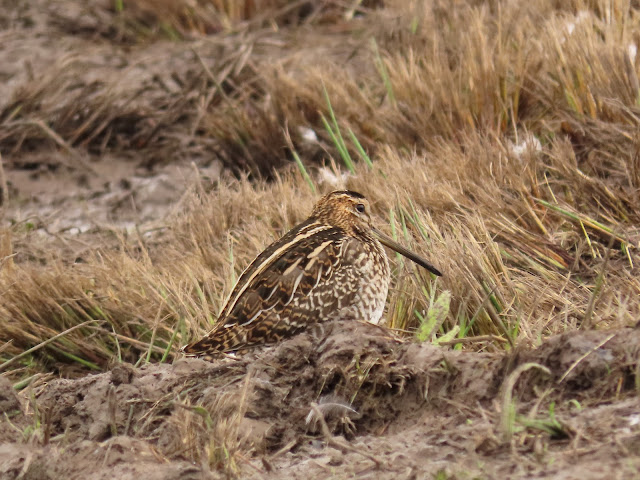Monday, 25 September 2023
GREY PHALROPE
Friday, 22 September 2023
SNAPPING A SNIPE AT SLIMBRIDGE
Slimbridge WWT centre was very quiet today, in respect of both people and birds. I saw a couple of families and a few other visitors and the hides had only a few occupants. It is that time of year when the summer flocks have gone and there is a wait before the winter bird visitors arrive. Even the passing migrants had moved on. The staff at Slimbridge have also obviously been very busy cutting back vegetation and preparing for the winter season.
The busiest place I found was South Lake where at the Hogarth hide there were snipe and ruff feeding quite close to the hide which was nice to see. Later a flock of black tailed godwits joined them. The most numerous birds were definitely lapwing.
From the Zeiss hide I could see two spoonbills but the waders and ducks being smaller, were harder to identify just through binoculars. I had hoped to find the wood sandpiper which was reported earlier but it sadly it wasn't showing. There were a few ruff and some spotted redshanks though.
Saturday, 16 September 2023
FARLINGTON MARSHES
I had a spare Saturday morning so decided that with nothing particular that took my fancy locally, I'd venture further afield to a reserve that I'd not visited before, near Portsmouth. Farlington Marshes is a coastal reserve and mostly popular for viewing wintering wildfowl but also has good numbers of waders at this time of the year.
It was a warm day, and although exposed to the sea, there was little wind and it was a pleasant walk around the 2.5 perimeter of the reserve. Initially I caught up with a small group of female birders who were pleased to help me identify some of the waders on the mudflat which could only be distantly identified with 'scopes although I could see the birds themselves in my binoculars. These included grey plovers, turnstones and a group of knot. I stayed around with the group for a little while as we looked over a small lagoon and some reed beds then decided to move on as I wanted to get round the whole of the reserve in the time I had. Although bearded tits can often be seen on the reserve, we could neither hear or see any today which was a pity.
Other birds of note were about a dozen or more ringed plovers interspersed with a few dunlin, good numbers of little egret and a large group of oyster catchers.
After completing the walk I re visited the lagoon where the rising tide had caused a large flock of grey plover to gather and I could more easily make out their changing plumage. There were also some yellow wagtails to be seen. Altogether I saw 40 species of bird so was pleased with that, including a couple new for the year.
TEMMINCK'S STINT AND YELLOW BROWED WARBLER AT SLIMBRIDGE
After a journey, somewhat lengthened by traffic and road closures, I arrived at Slimbridge shortly after opening time, where I was hoping to...

-
I read a blog recently which suggested that the hawfinches at Parkend were really not worth visiting, as the area is so busy with dog walk...
-
With a morning set aside for some birding while I was staying in Kent, I decided to focus on seeing species that I don't normally see ...
-
Another sunny morning brought out the butterflies in good numbers at Aston Upthorpe Downs near Didcot. Having left my car in the parking are...



































.JPG)
